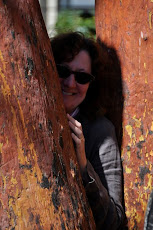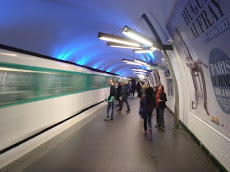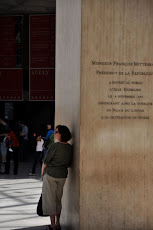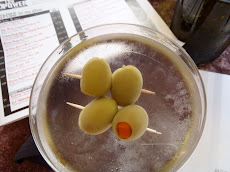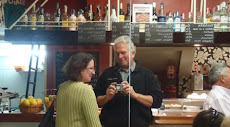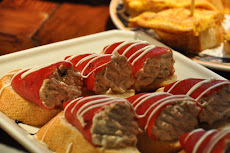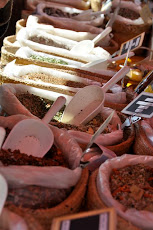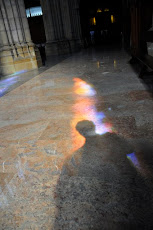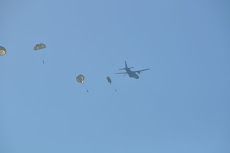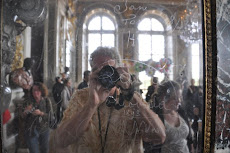
Click on the ATC to enlarge it for reading
..........................................................Just a place for musing and pictures
 It's rained for the last two days in Western Oregon--very unusual for this time of year. I walked outside tonight and the smell of an eastern summer in Pennsylvania or Ohio overcame me. I spent a few summers working on my Aunt Ellen's and Uncle Mike's dairy farm and the smell tonite took me back to summer evenings walking through hay fields hunting for groundhogs, although Mike was never too serious about hunting anything--he was relaxing after a day of pre-industrial farming.
It's rained for the last two days in Western Oregon--very unusual for this time of year. I walked outside tonight and the smell of an eastern summer in Pennsylvania or Ohio overcame me. I spent a few summers working on my Aunt Ellen's and Uncle Mike's dairy farm and the smell tonite took me back to summer evenings walking through hay fields hunting for groundhogs, although Mike was never too serious about hunting anything--he was relaxing after a day of pre-industrial farming.
 Nancy and I took a ride up the Mary's Peak road looking for good spots to take people on a field tour to discuss climate change and land use change and the impacts on forests, water and fish. Mary's Peak is a great place to look out over the Coast Range and the Willamette Valley. It's the highest point in the Coast Range and on a clear day you can see the Pacific Ocean and 9 volcanoes. You can also see the landscape pattern of forestry past and present and people moving to
Nancy and I took a ride up the Mary's Peak road looking for good spots to take people on a field tour to discuss climate change and land use change and the impacts on forests, water and fish. Mary's Peak is a great place to look out over the Coast Range and the Willamette Valley. It's the highest point in the Coast Range and on a clear day you can see the Pacific Ocean and 9 volcanoes. You can also see the landscape pattern of forestry past and present and people moving to  the margins of the forests. These days the "startling forestry" is done by private landowners and industry, not on federally-managed lands. There are few, if any, "regeneration harvests"--clearcuts--on Forest Service or BLM managed lands. The wildland-urban
the margins of the forests. These days the "startling forestry" is done by private landowners and industry, not on federally-managed lands. There are few, if any, "regeneration harvests"--clearcuts--on Forest Service or BLM managed lands. The wildland-urban  interface--Wooie, as in WUI, we call it in the biz--is changing the nature of the west. People live close to the woods and, around here, there are infrequent, but very large fires, the sort that go out when it snows. It sure should make people who live there think about fire and what it might be like in a future climate.
interface--Wooie, as in WUI, we call it in the biz--is changing the nature of the west. People live close to the woods and, around here, there are infrequent, but very large fires, the sort that go out when it snows. It sure should make people who live there think about fire and what it might be like in a future climate.
 Here a a few views of Alaska from a different perspective. On a recent trip I had a chance to look at the forest around Juneau from a helicopter. I'm not fond of them--a pilot once told me "There are only two kinds of helicopters: those that have crashed and those that are going to." Ours didn't or, should I say, hasn't yet. We flew over an area under consideration for a new experimental forest. It's quite beautiful and spans glacier to sea in a very short distance. I have to say, it's a great way to see Southeast. The last shot is Juneau set up against the mountains.
Here a a few views of Alaska from a different perspective. On a recent trip I had a chance to look at the forest around Juneau from a helicopter. I'm not fond of them--a pilot once told me "There are only two kinds of helicopters: those that have crashed and those that are going to." Ours didn't or, should I say, hasn't yet. We flew over an area under consideration for a new experimental forest. It's quite beautiful and spans glacier to sea in a very short distance. I have to say, it's a great way to see Southeast. The last shot is Juneau set up against the mountains.

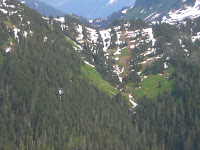









 logs, scorched trunks and crowns, just shadows of burned logs on the ground--like the shadows of people at Hiroshima that I've seen in pictures. Fire is fire.
logs, scorched trunks and crowns, just shadows of burned logs on the ground--like the shadows of people at Hiroshima that I've seen in pictures. Fire is fire. New things are growing. Seedlings, mosses, lichens, all sorts of bugs. The land isn't barren. Life isn't gone. It wasn't a catastrophe. No one died. Who knows what will be here 10 or 35 or 100 or 1000 years from now. Another fire? Insect infestation? Invading plant species? Off road recreation? Housing development? There are new roads not taken every day for this forest.
New things are growing. Seedlings, mosses, lichens, all sorts of bugs. The land isn't barren. Life isn't gone. It wasn't a catastrophe. No one died. Who knows what will be here 10 or 35 or 100 or 1000 years from now. Another fire? Insect infestation? Invading plant species? Off road recreation? Housing development? There are new roads not taken every day for this forest. That's where I come down on it.
That's where I come down on it.
